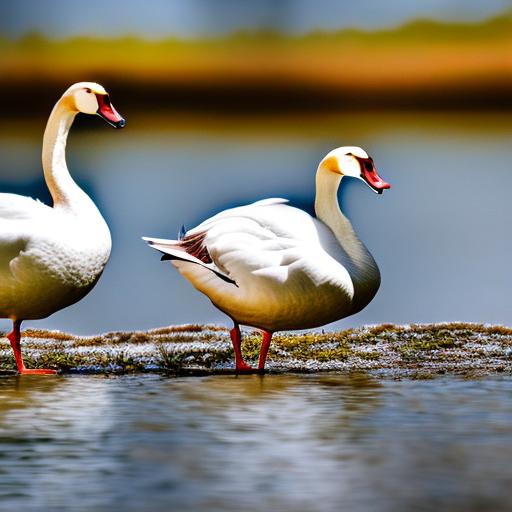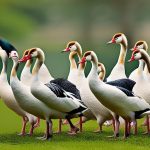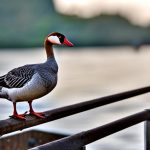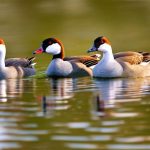Geese can be a nuisance in many areas, especially in urban and suburban environments. They are known for their aggressive behavior, especially during mating season, and can pose a threat to people, pets, and property. Geese are also notorious for leaving behind large amounts of droppings, which can create unsanitary conditions and damage the landscape. Additionally, their constant honking and squawking can be disruptive and annoying to residents and visitors alike. These issues make it important for property owners and managers to find effective ways to deter geese from congregating on their land.
One of the biggest challenges with geese is that they are highly adaptable and can quickly become accustomed to traditional deterrent methods. This means that simply shooing them away or using noise-making devices may only provide temporary relief. As a result, property owners are constantly seeking new and innovative ways to keep geese at bay.
Key Takeaways
- Geese can be a nuisance in certain areas, causing damage and creating unsanitary conditions.
- Plastic swans are used as a deterrent to keep geese away from certain areas.
- Plastic swans work by creating the illusion of a predator, causing geese to avoid the area.
- Using plastic swans can help maintain cleanliness and prevent damage caused by geese.
- Potential drawbacks of using plastic swans include the need for regular maintenance and the possibility of geese becoming accustomed to them.
The Use of Plastic Swans as a Deterrent
One method that has gained popularity in recent years is the use of plastic swans as a deterrent for geese. These lifelike decoys are designed to mimic the appearance of real swans, which are natural predators of geese. By placing these plastic swans in areas where geese tend to gather, property owners hope to create the illusion of a potential threat, causing the geese to seek out safer locations.
The use of plastic swans as a deterrent is an attractive option for many property owners because it is non-invasive and does not require the use of chemicals or other potentially harmful substances. Additionally, plastic swans are relatively low maintenance and can be easily moved to different locations as needed. This makes them a convenient and cost-effective solution for deterring geese from a variety of outdoor spaces, including parks, golf courses, and residential properties.
How Plastic Swans Work to Keep Geese Away
Plastic swans work by tapping into the natural instincts of geese. Real swans are known to be territorial and will aggressively defend their nesting and feeding areas from other waterfowl, including geese. By placing plastic swans in areas where geese are likely to congregate, property owners hope to create the illusion of a real swan presence, which may deter geese from settling in those locations.
The lifelike appearance of plastic swans is key to their effectiveness as a deterrent. These decoys are often designed with realistic coloring and features, such as reflective eyes and naturalistic poses, to make them appear as convincing as possible. When placed strategically near bodies of water or open grassy areas, the presence of these plastic swans can create a visual deterrent that may discourage geese from staying in the area.
In addition to their visual impact, some plastic swans are also designed to move with the wind or water currents, adding an extra layer of realism to their appearance. This movement can further enhance the illusion of a live swan presence, making it even more convincing to passing geese.
Benefits of Using Plastic Swans
There are several benefits to using plastic swans as a deterrent for geese. One of the main advantages is their non-invasive nature. Unlike other deterrent methods, such as chemical sprays or noise-making devices, plastic swans do not pose any risk to the environment or other wildlife. This makes them a safe and environmentally friendly option for deterring geese from outdoor spaces.
Another benefit of using plastic swans is their ease of use and low maintenance requirements. Once installed, these decoys require minimal upkeep and can be left in place for extended periods without the need for constant monitoring or adjustment. This makes them a convenient solution for property owners who want a hassle-free way to keep geese away from their land.
Additionally, plastic swans are a cost-effective option for deterring geese. Compared to other methods, such as hiring professional wildlife control services or installing physical barriers, plastic swans are relatively affordable and can provide long-term protection against geese without breaking the bank.
Potential Drawbacks of Using Plastic Swans
While plastic swans can be an effective deterrent for geese, there are some potential drawbacks to consider. One of the main concerns is that geese may eventually become accustomed to the presence of the decoys and learn that they do not pose a real threat. This could diminish the effectiveness of the plastic swans over time, requiring property owners to find alternative methods for deterring geese.
Another potential drawback is that plastic swans may not be effective in all situations. For example, in areas with high levels of human activity or where geese have become particularly habituated to human presence, the presence of plastic swans may not be enough to deter them from staying in the area. In these cases, property owners may need to consider additional deterrent methods or seek professional assistance to address the issue.
Finally, some property owners may find the appearance of plastic swans to be unsightly or out of place in their outdoor spaces. While efforts are made to design these decoys to be as realistic as possible, some people may still find them to be visually unappealing or disruptive to the natural aesthetic of their property.
Other Methods for Keeping Geese Away

In addition to using plastic swans as a deterrent, there are several other methods that property owners can consider for keeping geese away from their land. One common approach is the use of physical barriers, such as fences or netting, to prevent geese from accessing certain areas. While effective, these barriers can be costly to install and may not be practical for all outdoor spaces.
Another option is the use of sound-based deterrents, such as ultrasonic devices or noise-making machines. These devices emit sounds that are unpleasant to geese and can discourage them from staying in the area. However, like other traditional deterrent methods, geese may become accustomed to these sounds over time, reducing their effectiveness.
Some property owners may also choose to modify their outdoor spaces to make them less attractive to geese. This can include removing sources of food and water, such as bird feeders or standing water, and implementing landscaping changes that make it more difficult for geese to access certain areas.
Finally, professional wildlife control services can provide effective solutions for deterring geese from outdoor spaces. These services may include habitat modification, relocation efforts, or other targeted strategies for addressing specific issues with geese on a property.
The Effectiveness of Plastic Swans
In conclusion, plastic swans can be an effective and environmentally friendly option for deterring geese from outdoor spaces. Their lifelike appearance and non-invasive nature make them an attractive choice for property owners who want a convenient and cost-effective solution for keeping geese away from their land.
While there are some potential drawbacks to using plastic swans as a deterrent, such as habituation and visual concerns, these decoys can still provide long-term protection against geese when used in conjunction with other deterrent methods. By understanding how plastic swans work and considering their benefits and limitations, property owners can make informed decisions about whether this method is right for their specific needs.
Ultimately, the effectiveness of plastic swans as a deterrent for geese will depend on various factors, including the specific environment and behavior of the geese in question. Property owners should carefully assess their individual circumstances and consider consulting with wildlife control professionals to determine the best approach for addressing issues with geese on their land.
Plastic swans have been a popular choice for keeping geese away from ponds and lakes. However, there are other effective methods for deterring geese that are worth considering. One such method is using trained border collies to patrol the area and discourage geese from settling. According to a recent article on PoultryWizard, “Using Border Collies to Keep Geese Away” provides valuable insights into this alternative approach. The article discusses the benefits of using border collies as a natural and non-invasive way to manage geese populations, offering a sustainable solution for property owners. For more information on effective strategies for managing geese and other poultry-related topics, visit PoultryWizard.
FAQs
What are plastic swans used for?
Plastic swans are often used as a deterrent to keep geese away from certain areas. The presence of the swans can make the geese feel threatened and discourage them from settling in the area.
How do plastic swans keep geese away?
The presence of plastic swans can create the illusion of a predator in the area, which can deter geese from settling in the vicinity. Geese are naturally wary of potential threats, and the sight of a swan can make them feel unsafe and prompt them to find a different location.
Are plastic swans an effective method for keeping geese away?
Plastic swans can be effective in deterring geese from certain areas, but their success may vary depending on the specific circumstances. Factors such as the size of the area, the number of geese, and the persistence of the geese can all impact the effectiveness of using plastic swans as a deterrent.
Where are plastic swans commonly used to keep geese away?
Plastic swans are often used in various settings such as golf courses, parks, ponds, and other outdoor areas where geese may become a nuisance. These areas may use plastic swans as a non-harmful method to discourage geese from congregating in the area.
Do plastic swans harm the geese in any way?
Plastic swans are not designed to harm geese in any way. They are simply a visual deterrent that aims to make the geese feel uncomfortable and encourage them to find a different location.
Meet Walter, the feathered-friend fanatic of Florida! Nestled in the sunshine state, Walter struts through life with his feathered companions, clucking his way to happiness. With a coop that’s fancier than a five-star hotel, he’s the Don Juan of the chicken world. When he’s not teaching his hens to do the cha-cha, you’ll find him in a heated debate with his prized rooster, Sir Clucks-a-Lot. Walter’s poultry passion is no yolk; he’s the sunny-side-up guy you never knew you needed in your flock of friends!







